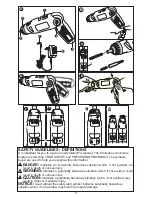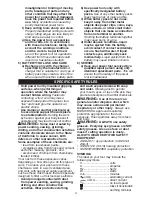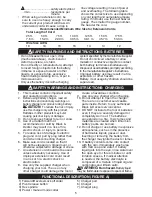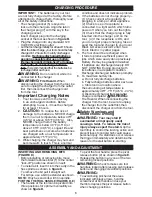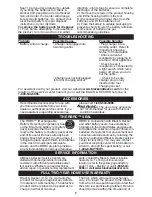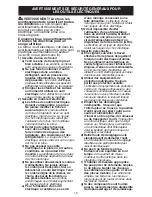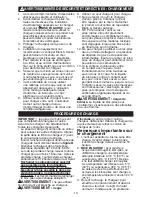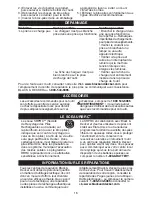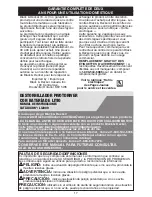
5
..................................safety alert symbol
.../min ..........................revolutions per
minute
• When using an extension cord, be
sure to use one heavy enough to carry
the current your product will draw. An
undersized cord will cause a drop in
line voltage resulting in loss of power
and overheating. The following table
shows the correct size to use depending
on cord length and nameplate ampere
rating. If in doubt, use the next heavier
gauge. The smaller the gauge number,
the heavier the cord.
Recommended Minimum Wire Size for extension Cords
Total Length of Cord
25 ft.
50 ft.
75 ft.
100 ft.
125 ft.
150 ft.
175 ft.
7.6 m
15.2 m
22.9 m
30.5 m
38.1 m
45.7 m
53.3 m
Wire Size AWg
18
18
16
16
14
14
12
• Do not disassemble or open, drop
(mechanical abuse), crush, bend or
deform, puncture, or shred.
• Do not modify or remanufacture, attempt
to insert foreign objects into the battery,
immerse or expose to water or other
liquids, or expose to fire, excessive
heat including soldering irons, or put in
microwave oven.
• Only use the battery / tool with a charging
system specified by the manufacturer/supplier.
• Do not short-circuit a battery or allow
metallic or conductive objects to contact
both battery terminals simultaneously.
• Dispose of used batteries promptly according
to the manufacturer/supplier’s instructions.
• Improper battery use may result in a fire,
explosion, or other hazard.
• Battery / tool usage by children should be
supervised.
SAfeTy WARNINgS AND INSTRUCTIONS: BATTeRIeS
SAfeTy WARNINgS AND INSTRUCTIONS: ChARgINg
1. This manual contains important safety
and operating instructions.
2. Before using battery charger, read all
instructions and cautionary warnings on
battery charger and product using battery.
CAUTION:
To reduce the risk of injury,
use this charger only with this product.
Batteries in other products may burst
causing personal injury or damage.
3. Do not expose charger to rain or snow.
4. Use of an attachment not
recommended or sold by Black &
Decker may result in a risk of fire,
electric shock, or injury to persons.
5. To reduce risk of damage to electric
plug and cord, pull by plug rather than
cord when disconnecting charger.
6. Make sure cord is located so that it
will not be stepped on, tripped over, or
otherwise subjected to damage or stress.
7. An extension cord should not be used
unless absolutely necessary. Use of
improper extension cord could result
in a risk of fire, electric shock or
electrocution.
8. Use only the supplied charger when
charging your tool. The use of any
other charger could damage the tool or
create a hazardous condition.
9. Use only one charger when charging.
10. Do not attempt to open the charger.
There are no customer serviceable
parts inside. Return to any authorized
Black & Decker service center.
11. DO NOT incinerate the tool or batteries
even if they are severely damaged or
completely worn out. The batteries
can explode in a fire. Toxic fumes and
materials are created when lithium ion
battery packs are burned.
12. Do not charge or use battery in explosive
atmospheres, such as in the presence
of flammable liquids, gases or dust.
Inserting or removing the battery from
the charger may ignite the dust or fumes.
13. If battery contents come into contact
with the skin, immediately wash area
with mild soap and water. If battery
liquid gets into the eye, rinse water over
the open eye for three minutes or until
irritation ceases. If medical attention
is needed, the battery electrolyte is
composed of a mixture of liquid organic
carbonates and lithium salts.
WARNINg:
Burn hazard. Battery liquid
may be flammable if exposed to spark or flame.
fUNCTIONAL DeSCRIPTION (fIgURe A)
1) Forward/Reverse/Lock off slider
2) Pivot release button
3) Hex spindle
4) Power / manual mode collar
5) Charger port
6) Charger
7) Charger plug
Summary of Contents for LI2000
Page 26: ...26 ...


